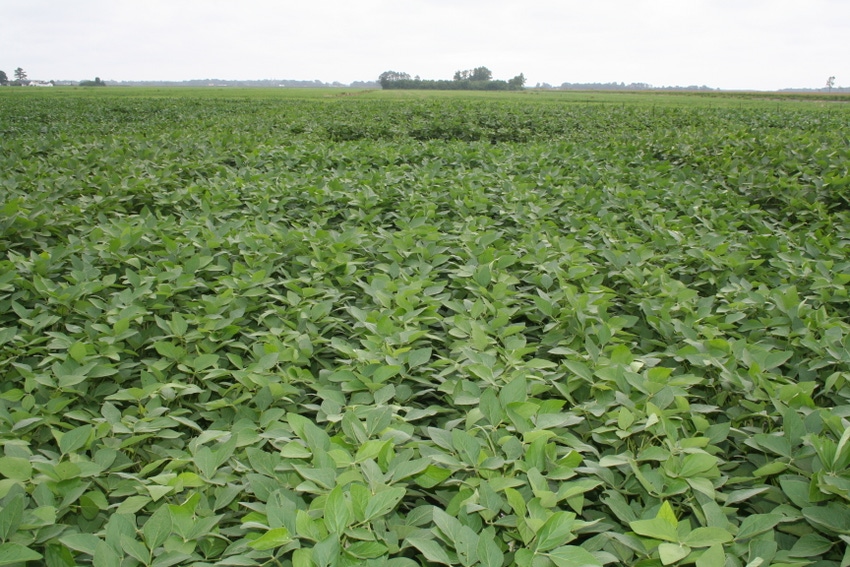February 2, 2014

Soybean acreage is likely to increase slightly in the upper Southeast in 2014, and the key to maximizing yield and quality is to select the optimum variety.
Speaking at the recent North Carolina All Commodities Conference, veteran North Carolina State University soybean specialist Jim Dunphy says growers have many good options to choose from in Maturity Groups IV through VIII.
Increasing acreage from the 1.5 to 1.6 million acre level of recent years is vitally important to both the row crop and livestock industries in the region. The Virginia-Carolina area is in a grain deficit state, and has been for a number of years, and increasing production of all feed crops is essential to livestock producers.
The year 2012 was a banner one for soybean production in the region, with both North Carolina and Virginia setting all-time records for statewide yield average. Combined with good prices, the record crop two years ago spurred an increase in acreage in 2013.
Though weather-related issues pushed yields down in the region, demand for soybeans and price remains good. Using 2012, which was a near ideal growing season for soybeans, as a barometer, Dunphy compared yield of 2013 soybean varieties to similar tests and similar sites from 2012.
In Group IV soybeans, there were seven varieties that topped a 12-bushel per acre increase from 2012 yield levels.
“These are based on one year of data, and I don’t get too excited about one year of production, but all these varieties, and a few others, did real well in our tests last year,” Dunphy notes.
“The challenge with Group IV soybeans is to get plants up big enough and quick enough to get the yield job done,” he adds.
Top performing Group IV beans include:
P4930 LL, which produced 22 percent more beans than last year
Armor 47-R13, 17 percent
SS 4725 NS R2, 17 percent
HBK LL 4953, 16 percent
P49T8 OR, 16 percent
SS 4711 N R2, 15 percent
P4850 RY, 13 percent
In Group V beans, the N.C. State tests produced eight varieties with at least a 10 percent yield gain over 2012 averages.
In several maturity groups, conventional soybean varieties were among the top performers. In Group V, JTN-5110, a conventional variety was the second highest performer, producing 14 percent above the average in 2012.
Other top-producing Group V varieties include Halo 5:01 45LL, 15 percent; 54LE 23, 12 percent; Halo 5 45LL; 32 RY 55, 11percent; and three other varieties at 10 percent above 2012 yield levels.
Group VI beans produced less increase from the 2012 average yield, but several of these are based on multiple year testing—some for four years, and Dunphy points out these carry much more value with him, than varieties from year testing only.
Check current soybean futures prices
The top producer in Group VI was S67-R6, which produced a one-year increase of 10 percent. NC Roy, another conventional variety was the second highest producer with a 5 percent increase, again, in one year of testing.
P6710 RY and S61 RY93, both produced an increase of 4 percent, but this total is based on four years of testing. One-year test varieties V61N 9RR and 62 02-4, produced 6 and 4 bushel increases, respectively, more than the 2012 average.
Groups VII and VIII were combined in the North Carolina tests in 2013. Most of these varieties have been tested for multiple years by the N.C. State researcher.
The top performing variety among the Group VII and VIII soybeans was N70 03 CN, a conventional variety that produced 10 percent more yield in a combined five years of testing in North Carolina.
“We’ve had this particular variety in our testing program for several years, so we feel confident with the results from 2013, much more so than we have with varieties that we’ve only seen for one year,” Dunphy explains.
Five-year test varieties among top performers in Groups VII and VIII include:
Woodruff (another conventional variety), 9 percent
S74-M3, 7 percent
P7311 RY, 7 percent
34RY 75, 7 percent
Many production and environmental factors will impact final yield of the 2014 crop, but none will be more important than the soybean seed the grower decides to put in the ground.
More from Southeast Farm Press
Stage set for Southeast cattle producers to make money in 2014
Research aims to take the guesswork out of determining peanut maturity
Farm bill primer: The basics of what to expect in near future
You May Also Like




